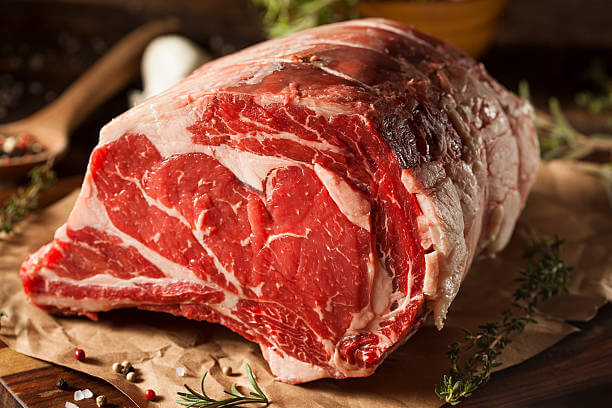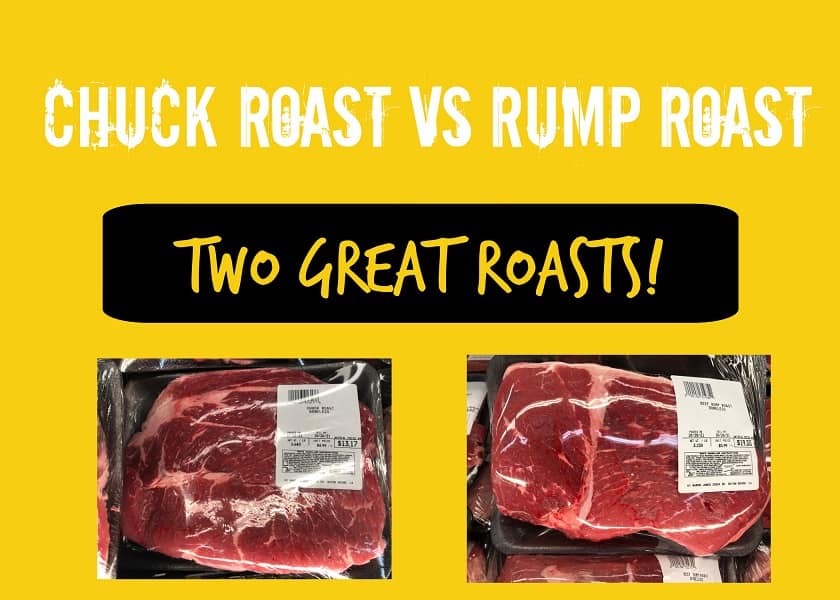Understanding Beef Cuts: Arm Roast Vs Chuck Roast

When it comes to beef cuts, it’s important to understand the difference between arm roast and chuck roast. Arm roast is obtained from the middle of the shoulder, while chuck roast comes from an area above the shoulder. Arm roast is generally considered more tender due to its lower connective tissue content. On the other hand, chuck roast is richer in connective tissue, making it a bit tougher and requiring longer cooking times. Additionally, chuck roast tends to be more fatty, which can result in a more flavorful taste.
Arm Roast Overview
Arm roast, also known as clod roast or pot roast, is a type of cut that is obtained from between the neck and shoulder of a cow. It is a lean sinew-connected piece of flesh with a round bone inside. The texture of arm roast is leaner and denser compared to chuck roast. While it may be less flavorful than chuck roast, it is still a versatile cut that can be used in various dishes. Arm roast is often cooked slowly on low-temperature settings, making it a popular choice for slow-cooker recipes. Compared to chuck roast, arm roast is generally more expensive.
Chuck Roast Overview
Chuck roast, also known as pot roast or chuck roll, is a cut of meat that comes from the center part of the shoulder of a cow. It is a tender piece of meat with connective tissue running through it, which gives it a rich and flavorful taste. The texture of chuck roast is denser compared to arm roast, and it is known for its marbling, which adds juiciness and tenderness to the meat. Chuck roast is often cooked using slow-cooking methods on low temperature settings, resulting in a melt-in-your-mouth texture. It is a more affordable option compared to arm roast.
Arm Roast Characteristics And Cooking Methods

Arm roast is characterized by its tenderness and mild flavor. It is a lean cut of meat with less fat compared to chuck roast. The arm roast is typically boneless and has a round bone in the center, which adds flavor during cooking.
When it comes to cooking methods, arm roast is versatile and can be prepared using various techniques. It is ideal for slow cooking, braising, or roasting. The low and slow cooking methods help to break down the collagen in the roast, resulting in a tender and flavorful meat. Arm roast can be seasoned with herbs and spices to enhance its taste.
Arm Roast Flavor Profile And Tenderness
Arm roast is known for its tender and melt-in-your-mouth texture. It has a subtle sweetness that adds depth to its flavor profile. The lean nature of this cut allows it to absorb flavors from marinades and seasonings, making it versatile and adaptable to various recipes. When slow-cooked or braised, arm roast becomes incredibly tender, making it ideal for pulled beef dishes or roast beef sandwiches. Its mild flavor makes it a crowd-pleaser, perfect for those who prefer a more delicate and nuanced taste in their beef.
Arm Roast Best Cooking Techniques
Arm roast is a versatile cut of meat that can be cooked using various techniques. Here are some of the best cooking methods for arm roast:
- Slow cooking: Slow cooking, such as braising or stewing, is an excellent way to tenderize arm roast and infuse it with flavors. Cook it low and slow for several hours to achieve a melt-in-your-mouth texture.
- Roasting: Roasting arm roast in the oven is another fantastic option. Season it with your favorite herbs and spices, then roast it at a moderate temperature until it reaches your desired doneness.
- Sous vide: For precise cooking and maximum tenderness, sous vide is a popular method. Vacuum-seal the arm roast and cook it in a precisely controlled water bath for an extended period to achieve perfect results.
No matter which technique you choose, make sure to let the meat rest before carving to allow the juices to redistribute and ensure a delicious and juicy final result.
Chuck Roast Characteristics And Cooking Methods

Chuck roast is known for its marbling, which consists of streaks of fat throughout the meat. This marbling gives the chuck roast a rich and beefy flavor. It also contributes to the tenderness and juiciness of the meat when cooked properly. Chuck roast is best suited for slow cooking methods, such as braising or pot roasting. These methods allow the connective tissues in the meat to break down and become tender. The result is a moist and flavorful roast that falls apart easily. Other popular cooking methods for chuck roast include smoking and roasting at low temperatures.
Chuck Roast Marbling And Texture
Chuck roast is known for its marbling, which consists of streaks of fat throughout the meat. This marbling gives the chuck roast a rich and beefy flavor. It also contributes to the tenderness and juiciness of the meat when cooked properly. The marbling in chuck roast adds moisture and flavor as it melts during the cooking process. However, the texture of chuck roast can be slightly more fibrous compared to other cuts of beef. Despite this slightly chewier texture, when cooked using appropriate methods, chuck roast can become incredibly tender and delicious.
Chuck Roast Recommended Cooking Methods
Chuck roast is best cooked using slow and low methods to ensure tenderness. Some recommended cooking methods for chuck roast include braising, pot roasting, and slow cooking in a crockpot or Dutch oven. These methods allow the connective tissues in the meat to break down, resulting in a tender and flavorful roast. Chuck roast can also be cooked on a grill or smoker using indirect heat for a smoky flavor. It is important to cook the chuck roast to an internal temperature of around 195°F/90°C for optimal tenderness.
Arm Roast Vs Chuck Roast: Nutritional Value Comparison

When comparing the nutritional value of arm roast vs chuck roast, there are some key differences to consider. Chuck roast typically has more fat and marbling, which adds flavor but also increases calorie and fat content. On the other hand, arm roast is leaner, with less fat and fewer calories. This makes it a great choice for those seeking a high-protein, low-calorie meal. Both cuts are good sources of protein and essential nutrients, but arm roast offers a healthier option for individuals looking to watch their fat intake.
Arm Roast Nutrient Content
Arm roast is a lean cut of beef that offers a range of essential nutrients. It is a good source of high-quality protein, providing all the essential amino acids needed for muscle growth and repair. Arm roast is also rich in vitamins and minerals, including iron, zinc, and B vitamins like niacin and vitamin B12. These nutrients support various functions in the body, such as red blood cell production and energy metabolism. With its low fat and calorie content, arm roast is a nutritious option for individuals looking to maintain a healthy diet.
Chuck Roast Nutritional Benefits
Chuck roast offers a range of nutritional benefits. It is a good source of high-quality protein, which is essential for muscle growth and repair. Chuck roast also contains significant amounts of vitamins and minerals, including iron, zinc, and B vitamins like niacin and vitamin B12. These nutrients play crucial roles in supporting various functions in the body, such as red blood cell production and energy metabolism. Despite its higher fat content compared to arm roast, chuck roast also provides essential fatty acids that are important for overall health. Including chuck roast in your diet can contribute to a well-rounded and nutritious meal.
Choosing Between Arm Roast And Chuck Roast

When it comes to choosing between arm roast and chuck roast, there are a few factors to consider.
- Tenderness: If tenderness is a priority, arm roast is the better option. It is leaner and more tender compared to chuck roast.
- Flavor profile: Chuck roast has more marbling and fat content, which results in a rich and juicy flavor. Arm roast, on the other hand, has a milder taste.
- Cooking method: Arm roast is well-suited for roasting or braising, while chuck roast excels in slow cooking methods like pot roasting or stewing.
Consider your personal preferences and the specific dish you plan to make when making your selection.
Factors To Consider When Selecting A Roast
When choosing between arm roast and chuck roast, there are a few factors to consider. First, consider the tenderness. If you prefer a leaner and more tender cut, then arm roast is the better option. However, if you enjoy the rich and juicy flavor that comes from marbling and fat, then chuck roast is the way to go. Additionally, think about the cooking method you plan to use. Arm roast is ideal for roasting or braising, while chuck roast excels in slow cooking methods like pot roasting or stewing. Ultimately, your personal preferences and the dish you’re preparing will guide your decision.
Best Uses For Arm Roast And Chuck Roast
Arm roast and chuck roast are versatile cuts of beef that can be used in a variety of dishes. The best uses for arm roast include roasting and braising, as these cooking methods help tenderize the lean meat and enhance its flavor. Arm roast is also perfect for slicing and making sandwiches or using it as a base for flavorful beef tacos. On the other hand, chuck roast is ideal for slow cooking methods like pot roasting or stewing, allowing the marbling and fat to melt into the meat, creating a rich and succulent flavor. Chuck roast is perfect for classic comfort dishes like pot roast, beef stew, and chili. Overall, arm roast and chuck roast can be enjoyed in a wide range of delicious and hearty meals.
Conclusion

In conclusion, comparing arm roast and chuck roast reveals important differences in flavor, tenderness, and cooking methods. Arm roast is a leaner cut, perfect for roasting, braising, and slicing for sandwiches or tacos. On the other hand, chuck roast, with its marbling and fat content, is best for slow cooking methods like pot roasting and stewing, resulting in a rich and succulent flavor. When choosing between the two, consider personal preferences, desired cooking techniques, and the specific dish you’re aiming to create. Regardless of your choice, both cuts provide delicious and hearty options for beef lovers.
Summary Of Key Differences Between Arm Roast And Chuck Roast
Arm Roast and Chuck Roast differ in several key aspects. Arm Roast is a leaner cut, while Chuck Roast is well-marbled with fat. In terms of flavor, Arm Roast has a subtle taste, while Chuck Roast offers a rich and succulent flavor. In terms of tenderness, Arm Roast tends to be more tender due to its lower fat content. When it comes to cooking methods, Arm Roast is well-suited for roasting, braising, and slicing, while Chuck Roast is best for slow cooking methods like pot roasting and stewing.
Recommendations Based On Personal Preferences
When choosing between Arm Roast and Chuck Roast, personal preferences play a crucial role in the decision-making process. If you prefer a leaner cut with a more subtle flavor, Arm Roast is the way to go. It is perfect for those who enjoy a tender and juicy roast. On the other hand, if you crave a richer and more succulent flavor, Chuck Roast is the clear winner. Its marbling provides a melt-in-your-mouth experience. Consider your desired flavor profile and tenderness level to make the best choice for your taste buds.
FAQ About Arm Roast Vs Chuck Roast: Comparing Beef Roasts
Q: What is the main difference between Arm Roast and Chuck Roast?
A: The main difference lies in the location of the cuts on the beef. Arm Roast is cut from the shoulder area, while Chuck Roast is taken from the neck and shoulder region.
Q: Which cut is more tender, Arm Roast or Chuck Roast?
A: Chuck Roast is generally more tender than Arm Roast due to the higher marbling of fat throughout the meat, which adds flavor and tenderness.
Q: How should Arm Roast and Chuck Roast be cooked?
A: Arm Roast is best cooked using moist heat methods like braising or slow cooking to break down the toughness of the cut. Chuck Roast can also be braised or slow-cooked for tender results, but it can withstand dry-heat cooking methods like roasting as well.
Q: Are there significant flavor differences between Arm Roast and Chuck Roast?
A: Yes, there are flavor variances between the two cuts. Arm Roast tends to have a leaner texture with less fat marbling, resulting in a slightly drier texture compared to Chuck Roast, which has more marbling and a richer, beefier flavor.
Q: Which cut is more suitable for certain recipes or dishes?
A: Arm Roast is excellent for dishes where it will be cooked for a longer duration, such as stews, pot roasts, or shredded beef dishes. Chuck Roast is versatile and can be used in various recipes, including traditional pot roasts, beef stews, steaks, and ground beef.

We are introducing OH! NANA, where culinary excellence meets sustainability! Our journey began with a passion for creating delicious, nutrient-dense dishes while minimizing waste and environmental impact. At OH! NANA, we believe that great taste and nutritional value can go hand in hand with responsible sourcing and production. Our commitment to delivering intense flavors and high nutritional value is paired with a dedication to reducing waste in every aspect of our operations. From sourcing fresh, locally-grown ingredients to implementing efficient kitchen practices, we strive to positively impact both your health and the health of our planet.